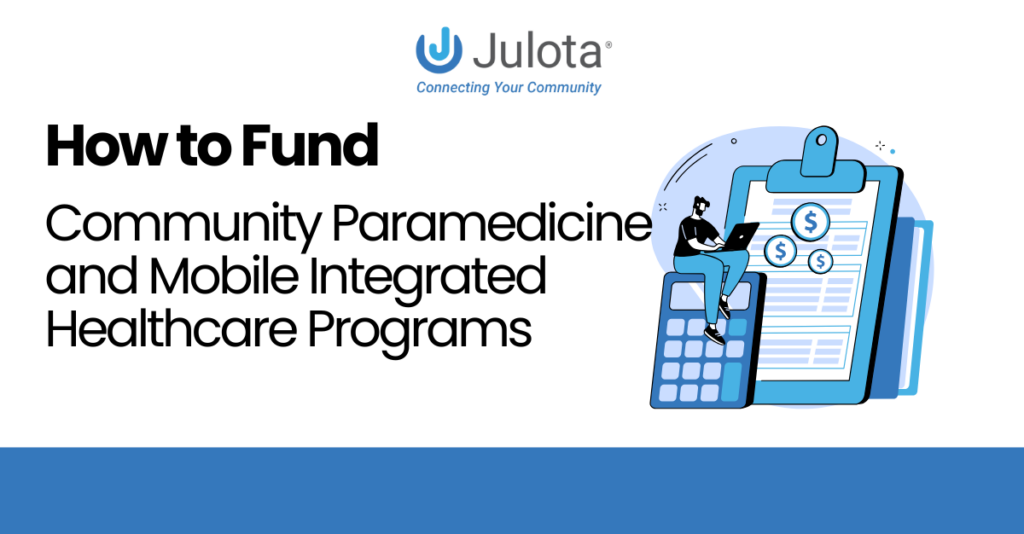Securing sustainable funding is one of the most critical challenges, and opportunities, for Mobile Integrated Healthcare (MIH) and Community Paramedicine (CP) programs. These innovative models bridge the gap between emergency response and long-term health outcomes, but they struggle to scale or even survive without proper financial backing. This article is a guide on how to fund community paramedicine and mobile integrated healthcare programs.

While there’s no one-size-fits-all solution, combining public, private, and innovative funding approaches can help ensure long-term financial sustainability. Below are ten proven funding strategies that MIH and CP programs can explore to support operations, demonstrate value, and build strong partnerships.
1. Integrate MIH Costs into Operational Budgets
One of the most straightforward funding strategies is integrating MIH expenses into the existing operational budgets of public and private EMS agencies. By reallocating funds from other budget categories—such as tax allocations, ambulance transport fees, or grant-supported programs—agencies can begin to cover the foundational costs of MIH without waiting for external funding.
This approach positions MIH services as a core component of EMS operations, rather than an experimental or auxiliary service.
2. Seek Foundation and Philanthropic Grants
Foundations and philanthropic organizations increasingly recognize the value of innovative healthcare delivery models. Many offer startup grants to fund community paramedicine and mobile integrated health programs, especially when those initiatives align with healthcare equity goals, chronic disease management, or rural healthcare access.
Often, these grants come with performance-based milestones, requiring the program to show outcomes like reduced emergency department visits or improved patient satisfaction to receive continued funding.
To attract this type of financing, tracking data and outcomes from the start and communicating your community impact is essential.
3. Hospital Partnerships to Reduce Readmissions
Hospitals are constantly under pressure to reduce readmission rates and control costs, especially under Medicare’s Hospital Readmission Reduction Program (HRRP), which penalizes institutions with excessive 30-day readmissions.
MIH programs offer a cost-effective solution. By delivering post-acute care and in-home follow-ups, MIH helps patients avoid unnecessary readmissions. This creates a natural incentive for hospitals to financially support or co-fund community paramedicine and MIH programs that reduce these costly penalties.
Sometimes, hospitals may even fund specific program components, such as transitional care visits, chronic care support, or 24/7 nurse lines.
4. Partner with Hospice Agencies
Hospice agencies are typically responsible for covering all patient care costs, including ambulance transports to emergency departments. Unnecessary transports represent a substantial and avoidable expense for these agencies.
Partnering with MIH programs allows hospice agencies to manage patients in place, avoid costly ED visits, and ensure comfort-focused care remains uninterrupted. This can lead to shared cost savings, making hospice organizations strong candidates for partnership-based funding.
5. Collaborate with Home Health Agencies
Home health agencies serve patients who are frequently at risk of readmissions or emergency calls due to chronic conditions or post-surgical needs. These patients often fall through the cracks of the healthcare system, relying on 911 as a default for care.
By collaborating with MIH programs, home health agencies gain a reliable partner to coordinate timely in-home care or wellness checks when a patient is in distress, without defaulting to an emergency room visit.
This improves care continuity, boosts patient satisfaction, and enhances the operational efficiency of both agencies, creating mutual financial and clinical benefits.
6. Work with Data-Driven Care Management Firms
Care management and health tech companies often use predictive analytics to identify high-risk or high-cost patients. However, they frequently lack the ability to deliver care in person.
MIH agencies are uniquely positioned to fill that gap. Partnering with these data-driven firms allows MIH providers to act as the boots-on-the-ground solution, providing in-home visits, follow-ups, or wellness checks for the most vulnerable patient populations.
These partnerships can include direct payments, shared savings models, or contracts for targeted interventions, especially if outcomes are tied to reduced hospitalizations or improved patient metrics.
7. Tap into Medicaid Reimbursement Models
In many states, Medicaid has already begun reimbursing MIH and CP services, particularly when programs demonstrate clear cost savings and improved outcomes.
This includes reimbursement for services like:
- In-home urgent care
- Behavioral health interventions
- Chronic disease management
- Post-discharge follow-ups
Though Medicaid rules vary by state, this is one of the most promising long-term funding solutions. Agencies can work with state health departments to pilot new models, join managed care organizations (MCOs), or lobby for inclusion in Medicaid waivers and value-based care programs.
8. Leverage Medicare Advantage and Private Insurers
While traditional Medicare has been slow to adapt and reimburse MIH services directly, private insurers and Medicare Advantage plans are already showing strong support.
Why? Because MIH programs help insurers reduce costs and improve patient outcomes, especially in high-risk populations. These insurers may fund:
- Post-discharge follow-up visits
- Chronic care coordination
- Behavioral health assessments
- Response fees for non-emergency care
Negotiating contracts or pilot programs with insurers, particularly those with a local footprint, can lead to sustainable reimbursement models tied to quality metrics or cost savings.
9. Explore Direct-to-Patient Revenue Models
In the age of on-demand services, some MIH agencies are testing direct-to-consumer models that let patients pay for services directly. These include:
- Monthly subscription services for home check-ins or wellness visits
- On-demand visits requested via non-emergency phone lines or mobile apps
- Membership programs with concierge-like services
Though these models won’t work for every community, they can be particularly effective in rural or underserved areas where traditional access is limited. Transparency in pricing and a strong community reputation are key to this model’s success.
10. Negotiate with Commercial Payers for Value-Based Contracts
Finally, many commercial insurance providers are moving away from traditional fee-for-service models and embracing value-based care arrangements. These include:
- Capitated payments (per-member, per-month fees)
- Bundled payments for specific conditions or outcomes
- Performance-based reimbursements tied to reduced ED visits or hospitalizations
MIH programs are ideally suited for these models, mainly when they focus on chronic disease management, behavioral health, or frequent 911 users (also known as “familiar faces”).
Building relationships with payers, sharing data, and clearly articulating your return on investment (ROI) are key to getting a foot in the door.
The Bottom Line: Focus on Demonstrating Value
While Medicare reform remains slow, focusing on local innovation and demonstrating value to stakeholders is the fastest way to build funding momentum. Whether working with Medicaid programs, hospitals, insurers, or patients directly, MIH and CP programs must track outcomes, tell their story, and prove their worth.
Start small if needed, but always think long-term. A Sustainable fund for community paramedicine is becoming more and more nessecary. By leveraging a mix of public, private, and alternative sources, MIH agencies can ensure they’re equipped to meet their communities’ evolving health needs while keeping operations financially viable.
If you’re building or scaling a community paramedicine program, remember that the care you provide saves lives. With the right strategy, it can also sustain itself for the long haul.
